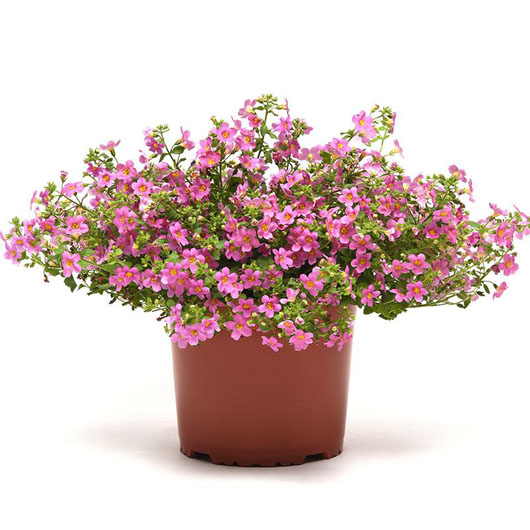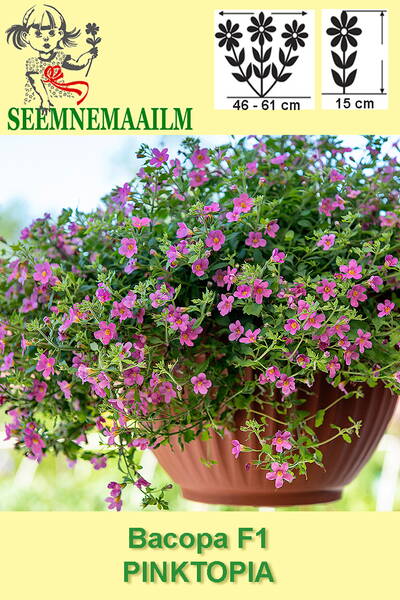The hot pink color is great for mixed containers and large planters. The size of the leaves is the same as in Snowtopia, but the color of the leaves is brighter green than that of Blutopia and Snowtopia.
Height - 15 cm.
Width - 46-61 cm.

Ornamental bacopa. Bot. syn.: Chaenostoma cordatum, Manulea cordata, Sutera diffusa hort.
* We start planting seedlings of most plants after the threat of frost has completely passed. If you bought ready-made seedlings, then, as a rule, they are hardened and ready for planting. If you grew them yourself, you will have to do the hardening yourself.
It is better to choose a cloudy day for planting: the lack of sun will help your plants better cope with the stress that planting is for them. You can also plant seedlings in the evening.
If there is a threat of frost, cover the plantings with paper or film at night.
If the seedlings do freeze, they need to be sprayed with cold water early in the morning and protected from sunlight so that they thaw gradually. In this case, they can fully recover.
Planting in boxes and containers.
The container where the plants are planted must be prepared: cover the drainage hole with a ceramic shard with the convex side facing up, pour a layer of broken shards or small stones on the bottom for drainage, fill it with soil to half the volume and compact it. The soil should be slightly damp. If you bought seedlings in pots, carefully shake them out by turning the pot over and tapping its edge on a hard surface, while holding the plant with your free hand. Seedlings are not removed from peat pots, but planted together with them. If the root system of the plant is not closed, try to preserve the earthen lump as much as possible. Place the plants in boxes or containers in accordance with your plan, fill the gaps with soil and compact them well. Compaction is necessary in order to avoid "air pockets" in the soil, since the roots, getting into such a "pocket", are deprived of the ability to feed and the plant may die. After compacting the soil, its level should be about 2.5 cm below the edge of the box so that water does not spill over the edge when watering.
After planting, you need to water the plants thoroughly and protect them from bright sunlight for several days.
At what distance from each other should plants be planted? It is believed that for the normal development of annual flowers, an interval of 20 cm is optimal. But in the conditions of a balcony, such a distance is an unaffordable luxury, and here we can use the method of shaded planting, that is, we plant one plant next to another as densely as the earthen lump with roots allows. With this method of planting, the plants will need more moisture and nutrients in the future - you will have to water and feed them more often, but the decorative effect can be achieved faster.
Planting in hanging baskets.
The technology of planting in a hanging basket differs from planting in a box. You will need moss (sphagnum, which grows in swamps and damp places in spruce forests, is ideal for this purpose) and thick foil or film. Cover the bottom of the basket with foil or film - this will be a tray that will hold water when watering. Place a layer of moss under the foil, which will decorate it.
Wrap the roots of the plants in moss without shaking off too much of the soil and push them inside the basket, starting from the bottom. Gradually fill the basket with plants, not forgetting to lay moss along the walls, and fill the middle with soil, compacting it. Plant several plants on top. Then water the plants and protect them from the sun for a while. Perhaps, at first, you will not like the appearance of the planting: the plants will look disheveled, despite all your efforts ...
Don't worry - a few days will pass, and everything will return to normal.
Other works.
Plant care includes a number of other tasks that will have to be done regularly (preferably at least once a week). These include:
♦ weeding - removing weeds;
♦ cleaning - removing dried leaves, flowers, shoots;
♦ loosening - the crust on the surface of the soil, often formed after watering, hinders air access to the roots, so it must be carefully broken up with any, not too sharp object or a special cultivator, trying not to damage the roots;
♦ removing ovaries - for almost all plants this stimulates further flowering;
♦ inspecting plants - to identify diseases and pests.
We do some work as needed. These are:
♦ pinching - removing the apical bud for better tillering (pinching is not done for all plants);
♦ pruning of overly elongated shoots to obtain a more compact shape and better flowering due to the growth of new shoots;
♦ garter - tall plants, long flower stalks, climbing plants may require supports in the form of pegs, trellises, stretched ropes, etc.
Cleaning up for the winter.
After the first frosts, we begin cleaning, unless, of course, you have not done this earlier and kept the plants, as they say, "until the last". By the way, if the frosts come late, then many cold-resistant plants look good in October - November, not afraid even of snowfalls.
You can prolong flowering by bringing small containers or hanging baskets into the house, but what remains outside and was exposed to frost can only be removed.
Do not wait until the soil freezes - carefully remove all plants, if possible, with the roots, and loosen the soil. If you leave containers and boxes on the balcony for the winter, make sure that the substrate in them does not become over-moistened as a result of autumn rains, otherwise, having frozen in the winter, it can damage the container, since water expands when frozen. Ceramic containers suffer especially from this, so it is better to remove the soil from them.












